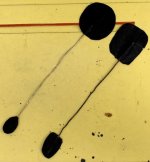bence8810
Well-known
x-ray, thanks so much for your very detailed message.
I have a condenser enlarger so I guess it'll produce results with higher contrast.
About the above note, I believe I will never have the experience you have, after all you did this mainstream and I only do it to please myself and hopefully sometimes family and others who look at my prints. Wouldn't call it art or work even...
To set such scientific standards will be hard for me and to be honest, I am not too keen on getting everything right. Many times I shoot without a meter. I enjoy old cameras and I enjoy shooting black and white. This means if I discover I should be shooting 1/3rd of a stop below the way a previous negative was produced at, I'd need to stop - meter and my subject would perhaps have already vanished.
Regardless of what will happen in my workflow going forward I will do the test you suggested above as I think I'll learn a lot from it.
I will also read books and will try to understand as much about the subject as possible.
But again, the way I shoot will perhaps never be as critical as I would need it to be if I wanted to get consistent and reproducible results.
About Dodging and Burning, I am 100% with you. I also don't have a single image I think where I didn't do something in Photoshop to change a part of an image. This is why from the second time I went to the darkroom I started experimenting with the blocking of light on certain parts etc. It is just something I want to always do, it is how I did it pre-wet printing my images in PS.
And this is why I am desperately trying to increase the time of enlargement, as it currently stands are 3-4 seconds maximum when I print 5x7. If I go larger I gain time but I don't always want to print large. With the small paper I can get 50 sheets for the price of 20 sheets of the larger. For practicing I think it's okay.
I am going to buy some slim wire over the weekend onto which I'll glue the shapes I need for dodging.
Ben
I have a condenser enlarger so I guess it'll produce results with higher contrast.
About the above note, I believe I will never have the experience you have, after all you did this mainstream and I only do it to please myself and hopefully sometimes family and others who look at my prints. Wouldn't call it art or work even...
To set such scientific standards will be hard for me and to be honest, I am not too keen on getting everything right. Many times I shoot without a meter. I enjoy old cameras and I enjoy shooting black and white. This means if I discover I should be shooting 1/3rd of a stop below the way a previous negative was produced at, I'd need to stop - meter and my subject would perhaps have already vanished.
Regardless of what will happen in my workflow going forward I will do the test you suggested above as I think I'll learn a lot from it.
I will also read books and will try to understand as much about the subject as possible.
But again, the way I shoot will perhaps never be as critical as I would need it to be if I wanted to get consistent and reproducible results.
About Dodging and Burning, I am 100% with you. I also don't have a single image I think where I didn't do something in Photoshop to change a part of an image. This is why from the second time I went to the darkroom I started experimenting with the blocking of light on certain parts etc. It is just something I want to always do, it is how I did it pre-wet printing my images in PS.
And this is why I am desperately trying to increase the time of enlargement, as it currently stands are 3-4 seconds maximum when I print 5x7. If I go larger I gain time but I don't always want to print large. With the small paper I can get 50 sheets for the price of 20 sheets of the larger. For practicing I think it's okay.
I am going to buy some slim wire over the weekend onto which I'll glue the shapes I need for dodging.
Ben




